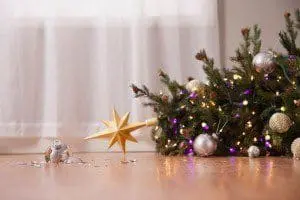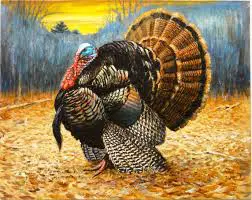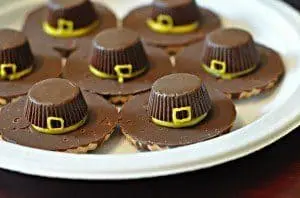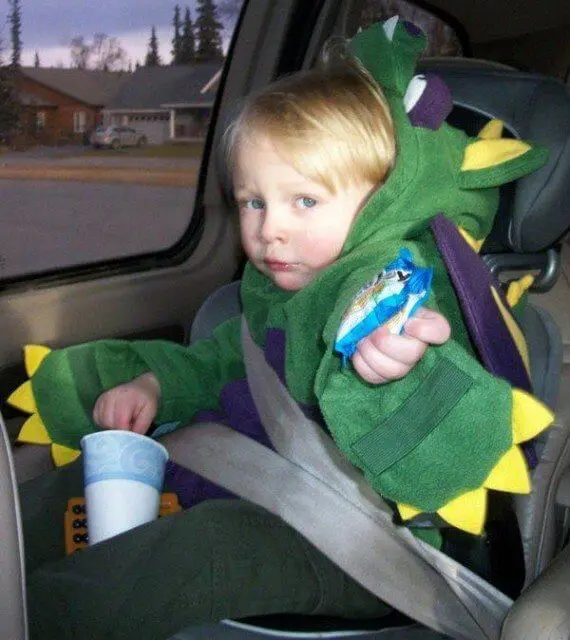When thinking of decorating for Christmas, most people think first of the Christmas tree. Twinkling lights, sparkling tinsel, shiny bulbs, and a new addition to the home, the Christmas tree is almost irresistible to a child. And while festive, a Christmas tree and/or its decorations can also seriously harm that same child. Ornaments can be broken and contain sharp hooks. Trees can be pulled over on top of children. Pine needles can be eaten–the list of possibly injuries is impressive, but luckily all of these child hazards can be prevented. This guide on how to child or baby proof a Christmas tree will provide simple, step-by-step instructions to Christmas tree safety for any age child to help ensure the entire family has a happy injury-free holiday.
When it comes to Christmas tree safety not all hazards apply to all children. The first step to child proofing your tree is an easy one; identify the risks that apply to your child’s age.
Here is a general break down of common injuries applying to different age groups:
Infants that cannot crawl: (generally 6 months and younger) Before mobility is achieved a Christmas tree holds little risk to a child. If they can’t get to the tree, they can’t be harmed by it. All you need to do is follow general Christmas tree safety tips to avoid electrical fires, etc. An average of 160 fires a year are caused by Christmas tree mishaps, don’t let your home be one of them.
Infants that can crawl, but have limited reach: (Usually 6 months to a year) Pulling on lower branches, removing decorations from lower branches, becoming tangled in cords, eating pine needles.
Toddlers: (From about a year to three years) Over all tree havoc, de-decoration of entire tree, broken ornaments, ornament hook injuries, knocking the tree over, attempting to eat smaller decorations, etc.
Pre-school: (Four years and up) By the time a child hits pre-school, the dangerous of Christmas trees reduce dramatically. There is little risk involved.
Christmas tree safety for crawling babies:
One of the main steps to Christmas tree safety for a child that can only crawl is to either buy a very fresh tree or go for an artificial Christmas tree. Trees that become dry not only pose a greater fire risk, but they shed far more needles. Crawling children are at floor level, so shed Christmas tree needles are especially appealing. An artificial tree eliminates this problem altogether. A fresh tree, properly cared for will also shed less needles.
The second step to Christmas tree safety for crawlers is to secure the tree. Curious children often reach up and grab a hold of branches pulling Christmas trees to the ground and on top of themselves. There are a few methods of preventing this.
-You can mount or secure the tree. In this method, you screw or fasten the Christmas tree to the floor or what ever the tree is placed on securely. You should be able to tug on the tree without it falling.
-You can place the tree on a raised surface. This often requires a smaller Christmas tree be used, but for crawling children with limited reach placing the tree on a coffee table or other raised surface is often effective.
-You can gate off the tree. While not particularly attractive you can use a baby gate to build a box around your tree preventing a crawling child from being able to reach it. Another option in this same category is to place the tree in a room with a door that can be closed or gated.
The last step to creating a baby-proof tree for crawling children is to be wary of low decorations. Place any breakable ornaments up high and well out of the reach of the child, and be sure they are securely attached. You can use plastic bulbs with ribbons ties if you wish to have an even distribution of ornaments. When hanging lights keep them deeper into the tree’s branches, close to the trunk, and tightly wrapped so that your child can’t pull the strings from the tree. Where the cord for the lights comes from the tree to the electrical outlet should be properly secured. You can tape the cords down and then cover them with a tree skirt. Any unused outlet plugs should be covered with a child safety outlet cover.
Christmas tree safety for a toddler:
When child proofing a Christmas tree for a toddler, all of the tips covered in step one can be used, however, some suggestions will no longer be effective as a toddler has more reach and mobility than a crawling baby.
With a toddler the raised tree method is not recommended as they are more likely to still be able to pull the tree down. The Christmas tree can then either be very securely mounted, fastened to the floor, or gated off entirely. If you make your tree inaccessible to your kids, no more measures of Christmas tree safety are required, but then, what fun is that?
If you choose to simply mount or secure your tree, avoid using breakable ornaments even at the top of your tree. Store them away until your child is of a safe age. Plastic ornaments can be used instead. This is also a great time to make your own Christmas ornaments with your child from paper or popcorn for example. Avoid small decorations that may be a choking hazard. Be sure not to use metal hooks when attaching ornaments– stick to ribbon or string.
Extra tip: To appease children that simply will not stop de-decorating your Christmas tree, a basket of extra ornaments can be placed next to the tree for playing with.




